The technology that entered the market just about a year ago is already making waves across the business landscape. Businesses are beginning to witness measurable results, and projects are no longer confined to pilot phases. Today, we’ve reached a common ground: Agentic AI is not just a buzzword anymore, it has become a game-changer capable of transforming business processes. From automating repetitive tasks to intelligently enhancing customer experiences, it is delivering on its promises, and its potential continues to expand.
Engineering teams are unlocking new capabilities every day, pushing the boundaries of what Agentic AI can achieve in real-world business contexts. For enterprises, understanding these breakthroughs is critical. It enables leaders to translate operational complexity into clarity, accelerate decision-making, optimize human effort for strategic initiatives, and remain agile in dynamic markets where supply chains shift overnight, and customer expectations continually evolve.
That’s why this blog dives into the most transformative Agentic AI trends of 2025. By spotlighting the latest breakthroughs, enabling technologies, and real-world applications already reshaping industries, it provides business leaders with a clear, actionable view of the market, helping them navigate risks confidently, seize opportunities faster, and align strategies with the future of enterprise innovation.
Why agentic AI matters for enterprises in 2025
Enterprises in 2025 face an unprecedented combination of market volatility, shifting customer expectations, and operational complexity. Traditional workflows struggle to keep pace, leaving leaders seeking tools that do more than just automate routine tasks.
Agentic AI trends 2025 highlight how enterprises can act autonomously, reduce human effort, and transform enterprise data into actionable strategies. Understanding these breakthroughs is critical, not just to stay competitive but to thrive in a rapidly evolving business landscape.
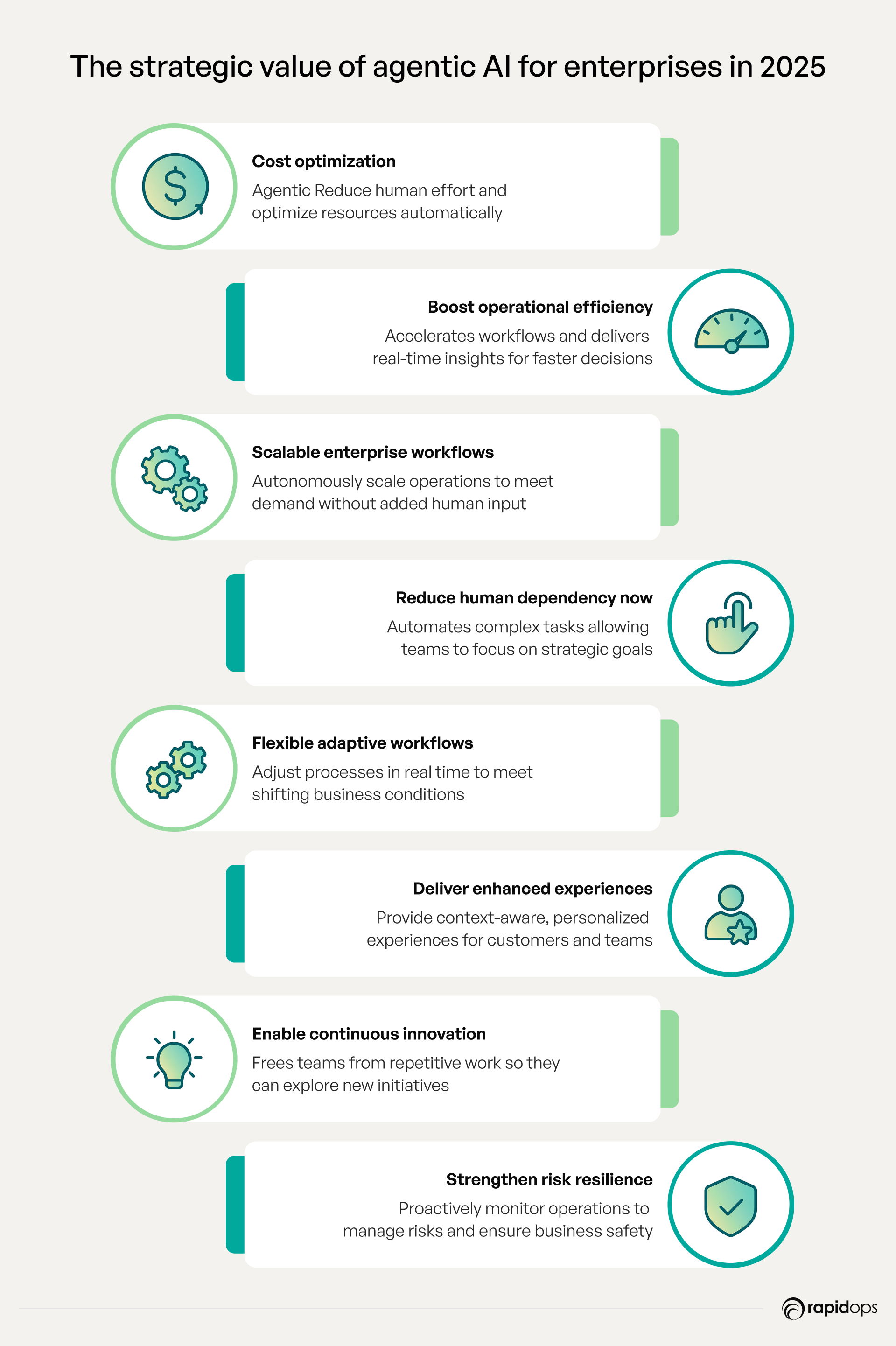
1. Cost optimization
Rising operational overhead and unpredictable market conditions make efficient resource management essential. Agentic AI systems handle both routine and complex tasks autonomously, reducing human effort and minimizing errors. This allows teams to focus on strategic initiatives, innovation, and high-value projects, while organizations optimize costs and achieve better resource utilization across core workflows.
2. Efficiency
Enterprises often struggle with bottlenecks that slow decision-making and operational execution. Multiple AI agents, orchestrated within agentic AI systems, accelerate workflows, convert hours of manual work into minutes, and deliver real-time insights from enterprise data. Leaders can respond faster to market changes, make informed decisions, and maintain agility in dynamic environments.
3. Scalability
As enterprises grow, expanding human teams proportionally is often impractical. Agentic AI systems enable autonomous scaling of workflows, allowing organizations to manage rising workloads without increasing human input. This ensures enterprises can meet demand, maintain service quality, and continue delivering value without operational disruption.
4. Reduced human dependency
Minimal human intervention is becoming critical as operational complexity rises. Agentic AI reduces reliance on manual processes by automating predictable and sophisticated tasks while maintaining accuracy. Human effort can be redirected toward customer engagement, innovation, and strategic priorities, empowering teams to focus on what matters most for growth.
5. Flexibility
Market conditions, regulatory landscapes, and internal priorities shift constantly. The adaptive learning capabilities of agentic AI systems, combined with specialized agents, allow enterprises to adjust workflows in real time. By integrating seamlessly with existing systems, these solutions provide resilience, continuity, and alignment with evolving business goals.
6. Enhanced experiences
Meeting the expectations of customers and employees is more challenging than ever. Agentic AI enables real-world applications that deliver personalized, context-aware experiences. From tailored customer recommendations to dynamic workforce support, enterprises can consistently deliver superior experiences that drive satisfaction, loyalty, and productivity.
7. Innovation enablement
Operational constraints often limit the ability to experiment and innovate. By automating repetitive and complex tasks, Agentic AI systems free teams to explore new business models, agile prototypes, and strategic initiatives. Continuous learning and autonomous decision-making accelerate time-to-value, allowing enterprises to innovate rapidly and confidently.
8. Risk resilience
Disruptions, vulnerabilities, and compliance requirements pose ongoing risks. Agentic AI systems embed risk management into decision-making, proactively monitoring operations, identifying threats, and recommending corrective actions. This ensures enterprises can respond quickly to uncertainties, protect critical functions, and strengthen long-term resilience.
Top agentic AI trends in 2025
1. Autonomous enterprise workflows
At its core, agentic AI has always been designed to handle workflows autonomously, but in 2025, enterprises are seeing these capabilities scale and deliver tangible results. AI agents now manage end-to-end operational processes independently, reducing manual effort, accelerating efficiency, and maintaining alignment with organizational goals.
While adoption is still expanding, companies that have successfully implemented these systems are already far ahead, achieving faster cycle times, fewer errors, and stronger compliance.
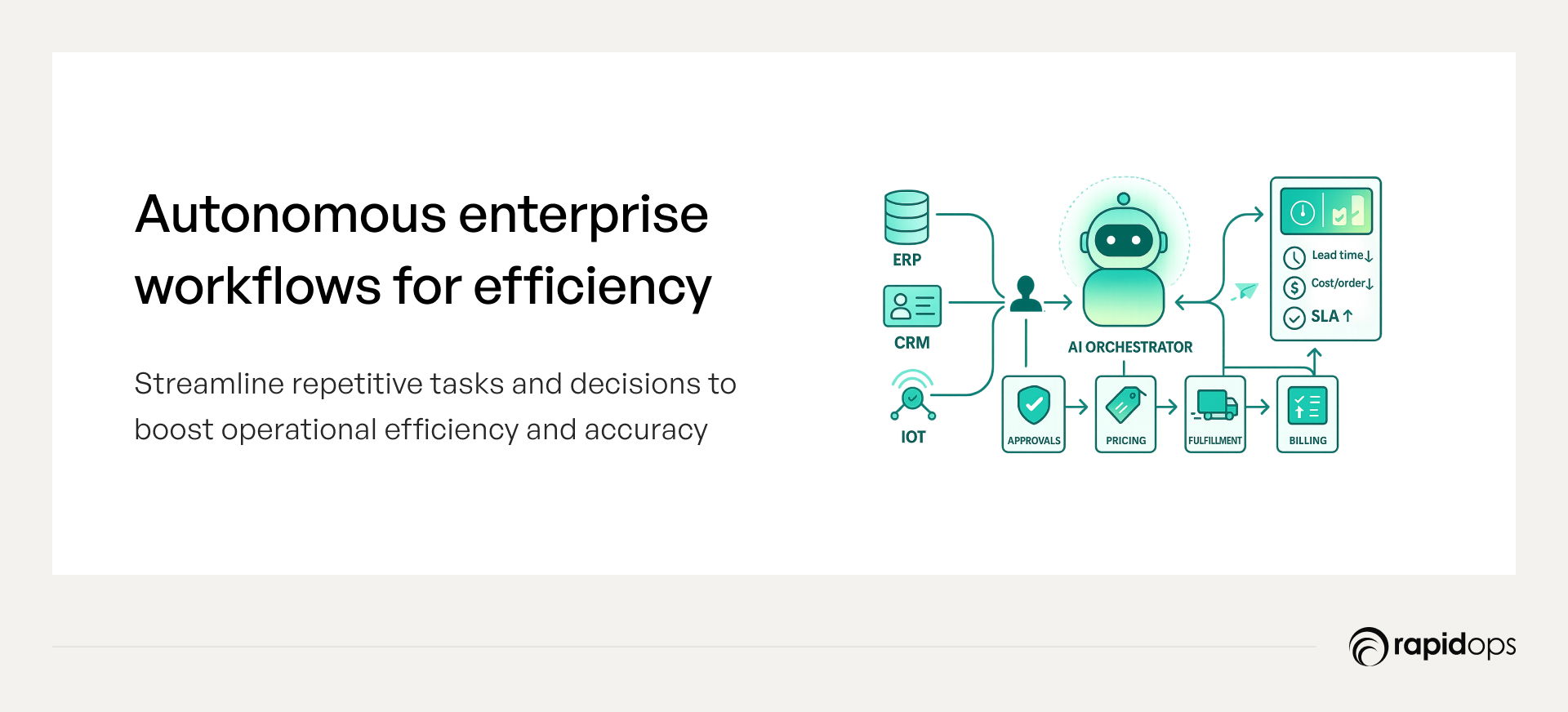
The power behind autonomous workflows
Routine operational tasks such as approvals, order processing, reporting, and internal communications are executed autonomously by AI agents. These agents follow predefined rules while adapting dynamically to changing conditions, acting in real-time to maintain workflow continuity and operational accuracy. By managing routine processes, they free human teams to focus on strategic initiatives and high-value work.
Real-world applications
Agentic AI is applied across enterprises to:
- Procurement cycles: autonomously handle purchase requests, approvals, and vendor communications.
- Invoice processing: manage large volumes of financial documents with precision and compliance.
- Internal approval chains: route, track, and complete approvals across departments without manual intervention.
- Cross-team orchestration: coordinate tasks among multiple AI agents to ensure seamless execution across workflows.
Measurable business impact
Organizations leveraging autonomous workflows report:
- Faster cycle times across operational processes.
- Reduced manual errors and greater compliance adherence.
- Operational efficiency gains allow human teams to focus on innovation and strategic priorities.
Strategic relevance
Autonomous enterprise workflows are a core capability of agentic AI, forming the foundation for scalable, agile operations. Enterprises that have embraced these systems are strengthening resilience, responding swiftly to market changes, and establishing a competitive advantage. By transforming routine operations into autonomous, adaptive processes, agentic AI sets the stage for enterprise-wide transformation and sustainable growth.
2. Multi-agent collaboration ecosystems
Building on autonomous workflows, multi-agent collaboration has become a core capability of agentic AI systems. In 2025, enterprises are increasingly witnessing AI agents working collectively across departments, orchestrating complex tasks with minimal human intervention. While adoption is still expanding, organizations that have implemented collaborative agentic AI ecosystems are already realizing measurable improvements in operational efficiency, responsiveness, and cross-functional alignment.
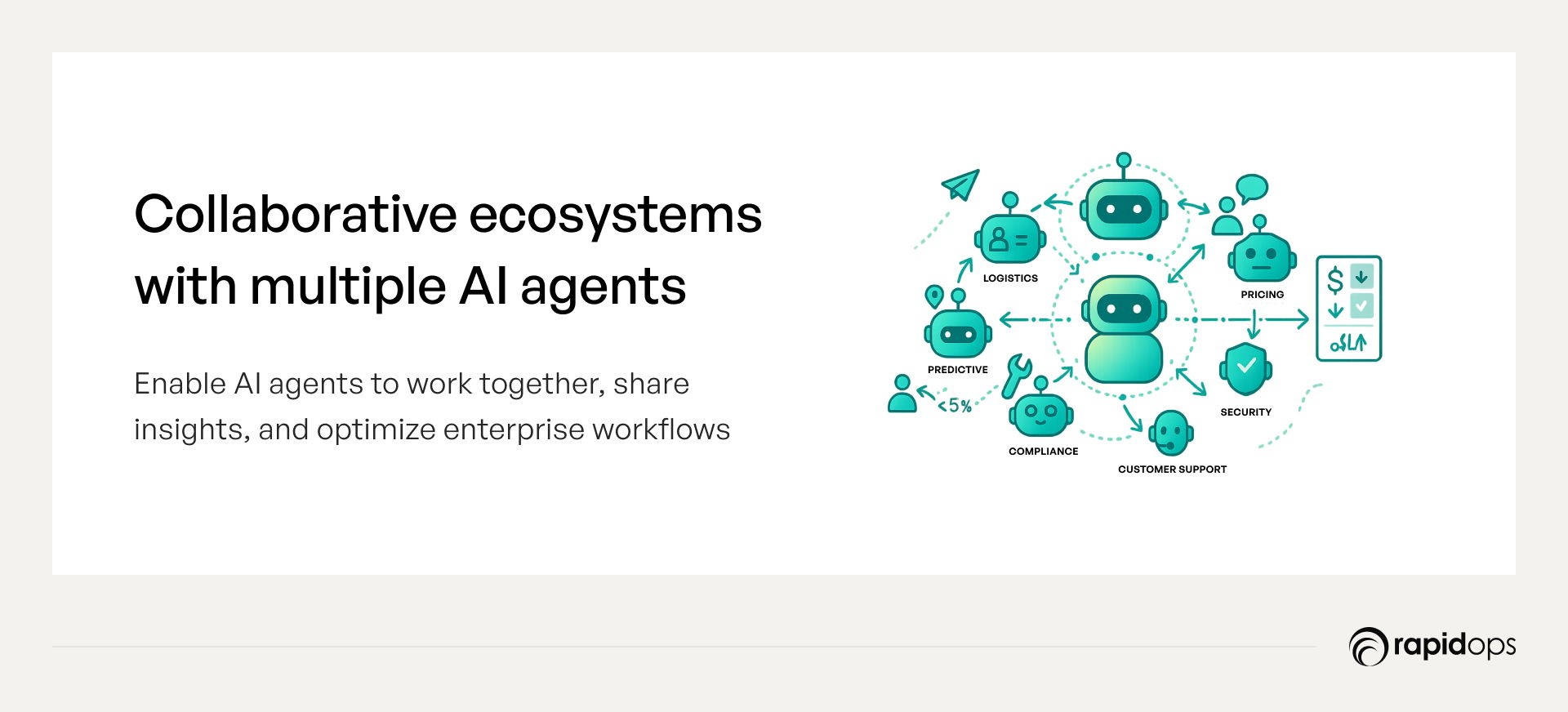
Driving enterprise impact through agentic AI
At the strategic level, teams of agentic AI systems communicate, share enterprise data, and synchronize actions to achieve business goals. This collaboration extends beyond individual tasks, allowing multiple AI agents to coordinate across workflows, adapt dynamically to changing environments, and optimize outcomes autonomously in real time. By leveraging autonomous decision-making, continuous learning, and specialized agents, enterprises reduce human effort while maintaining accuracy and alignment across complex operations.
Real-world applications
Enterprises are deploying multi-agent agentic AI systems to:
- Logistics optimization: Agents autonomously plan routes, balance workloads, and adjust delivery schedules using real-time insights.
- Predictive maintenance: AI agents monitor equipment, forecast failures, and coordinate interventions across production lines.
- Dynamic pricing: Multiple AI agents analyze market trends and competitor data to adjust pricing in real time, maintaining profitability.
- Cross-departmental planning: Agents synchronize resource allocation, project timelines, and workflow dependencies to ensure seamless operations.
Measurable business impact
Organizations leveraging these multi-agent ecosystems report:
- Reduced operational bottlenecks and optimized resource utilization.
- Faster responses to market trends and dynamic conditions.
- Accelerated workflows enabling real-time decision-making, efficiency gains, and cost savings.
Strategic relevance
Beyond operational improvements, multi-agent collaboration strengthens cross-functional alignment, supports enterprise-wide decision intelligence, and provides a scalable foundation for deploying specialized agents across industries. Early adopters are achieving a competitive advantage by transforming siloed processes into synchronized, adaptive ecosystems, showcasing the tangible strategic impact of agentic AI trends 2025.
3. Human-on-the-loop for complex workflows
While autonomous workflows remain a core capability of agentic AI, certain highly complex, high-stakes, or ambiguous processes benefit from selective human oversight.
Human-on-the-loop ensures that agentic AI systems maintain efficiency while critical judgments, ethical considerations, or nuanced decisions receive guidance only humans can provide. This approach complements autonomous operations without diminishing their value, creating a balanced framework for enterprise adoption.
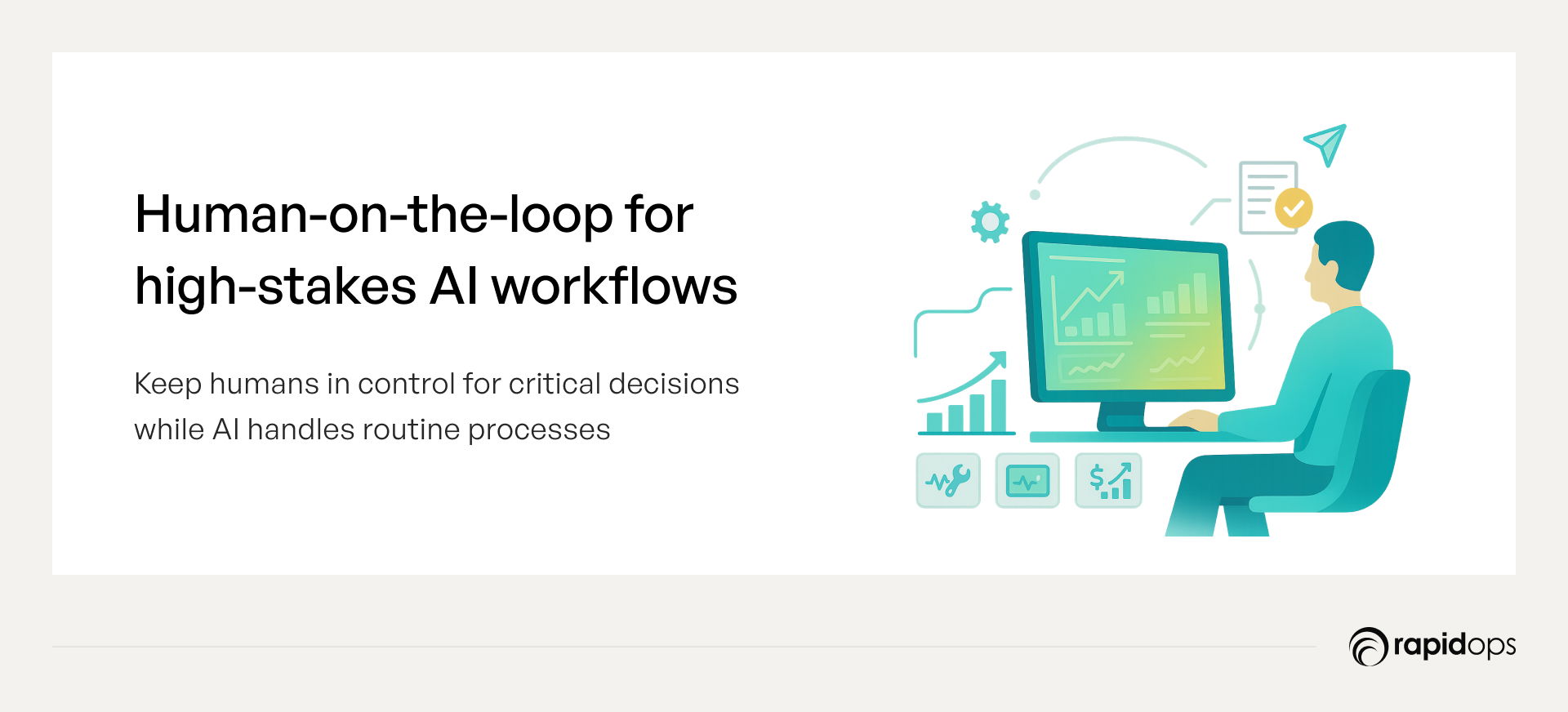
Balancing autonomy with human oversight
Humans intervene selectively in workflows where stakes are high, ambiguity exists, or regulatory, ethical, or strategic considerations demand nuanced decisions. These interventions refine, validate, and guide agentic AI outcomes, maximizing accuracy, trust, and operational resilience. By combining human input with the capabilities of agentic AI, enterprises optimize decision-making across critical workflows while sustaining speed, reliability, and alignment with business goals.
Real-world applications
Agentic AI with human-on-the-loop enhances critical enterprise workflows:
- Regulatory compliance reviews: Agentic AI autonomously processes data and flags exceptions, while humans approve final compliance decisions.
- Sensitive financial approvals: AI systems execute calculations, detect anomalies, and humans validate high-value transactions.
- Ethical AI evaluations: Agentic AI identifies patterns and risks, while humans assess ethical considerations before action.
- Exception handling in customer service: AI manages standard interactions, while humans step in for complex or high-impact cases.
Measurable business impact
Enterprises achieve higher accuracy, maintain compliance, and build confidence in agentic AI adoption. Strategic human interventions enhance trust in mission-critical workflows, while automation speed and efficiency remain uncompromised, delivering measurable productivity and operational gains.
Strategic relevance
Incorporating human-on-the-loop strengthens adoption, ensuring critical decisions benefit from human intuition without slowing broader enterprise processes. This balance between autonomy and selective intervention enhances trust, operational resilience, and strategic outcomes, enabling organizations to scale agentic AI trends 2025 confidently across complex workflows.
4. Industry-specific agents replacing generic copilots
As enterprises advance in AI adoption, generic AI co-pilots often lack the precision needed to address sector-specific challenges. Agentic AI systems now power industry-specific agents that autonomously manage highly specialized processes, learning from enterprise data to make informed decisions, optimize operations, and deliver outcomes aligned with unique business objectives. These agents extend beyond routine automation, embedding intelligence directly into critical workflows and enabling enterprises to operate with enhanced speed, accuracy, and agility.
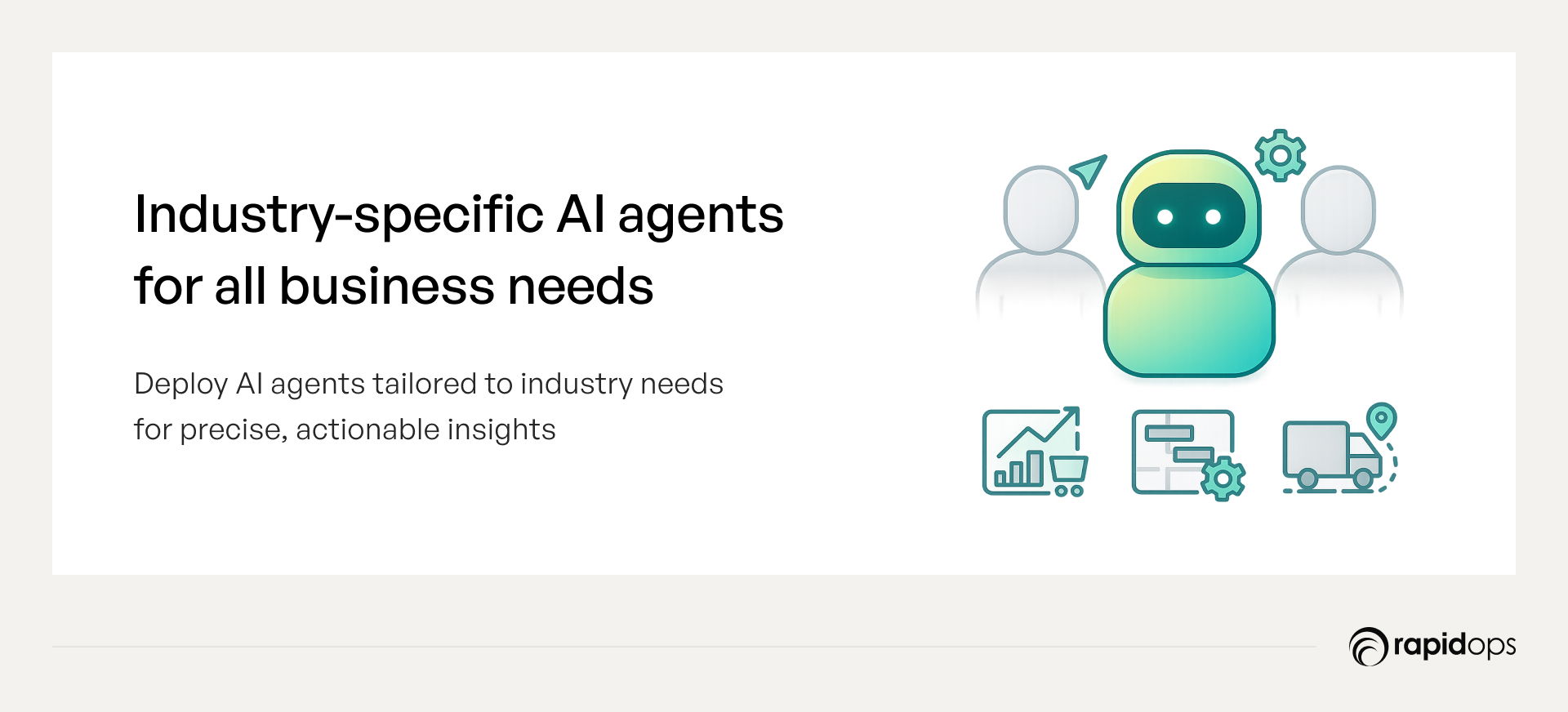
Customized intelligence for your industry
Industry-specific agents are specialized Agentic AI systems tailored to address processes unique to a particular sector, rather than applying generalized approaches. They act autonomously across core workflows, continuously adapting to changing conditions and leveraging unstructured data and predictive analytics to improve decision-making, minimize operational friction, and generate measurable business value. By aligning AI capabilities with sector-specific demands, these systems empower enterprises to drive tangible strategic outcomes.
Real-world applications
Enterprises are deploying industry-specific Agentic AI agents across multiple sectors:
- Retail: Autonomously manage merchandising, optimize inventory levels, and run dynamic promotions to ensure products are available where and when customers demand them, maximizing revenue while minimizing waste.
- Manufacturing: Specialized agents optimize production schedules, predict quality deviations, and plan preventive maintenance, reducing downtime, improving throughput, and enhancing operational precision.
- Distribution: AI agents orchestrate warehouse operations, plan fleet routes, and manage complex supply chains by analyzing data in real time, adapting logistics, and responding proactively to demand fluctuations or disruptions.
Measurable business impact
Organizations implementing industry-specific Agentic AI report higher operational precision, faster cycle times, and reduced resource waste. By automating sector-critical workflows, enterprises free human teams to focus on strategy, innovation, and high-value decision-making, turning enterprise data into actionable insights that maximize business impact.
Strategic relevance
By embedding agentic AI capabilities into specialized workflows, enterprises directly support business goals, enhance operational efficiency, and scale seamlessly across departments. Industry-specific agents convert data into strategic intelligence, creating a foundation for sustained competitive advantage, robust adoption of Agentic AI trends 2025, and measurable productivity gains across the organization.
5. AI agents for supply chain resilience
Modern enterprises face constant volatility in supply chains, where delays, disruptions, or demand shifts can cascade into significant operational challenges. Agentic AI equips organizations with intelligent systems that enable continuous monitoring, risk detection, and autonomous decision-making, enabling supply chains to operate proactively rather than reactively. Businesses adopting these solutions at scale are already realizing measurable improvements in efficiency, responsiveness, and strategic control, underscoring the essential role of agentic resilience in 2025.
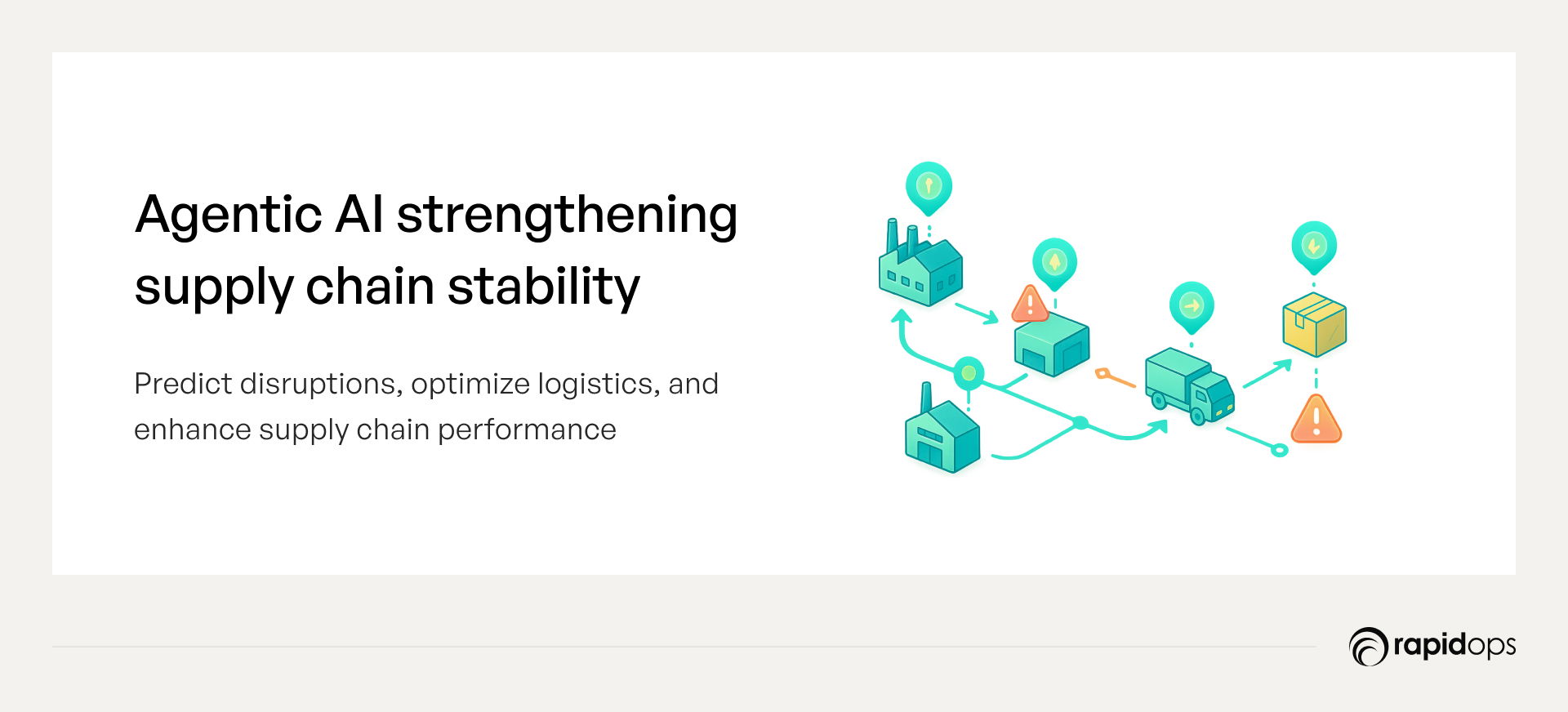
How agentic AI strengthens supply chains
Agentic AI continuously oversees supply chain operations, identifying potential risks, optimizing procurement, and autonomously adjusting processes to maintain seamless performance. By leveraging predictive analytics, real-time data, and historical trends, these systems manage complex, dynamic supply chains with minimal human intervention. This enables faster, data-driven decisions without compromising accuracy, operational stability, or strategic outcomes.
Real-world applications
Enterprises are applying Agentic AI for supply chain resilience in practical scenarios:
- Predictive inventory management: Autonomously analyzes historical sales, demand signals, and market trends to forecast inventory needs, dynamically rebalancing stock across locations without manual input.
- Demand-supply balancing: Continuously monitors procurement, production, and logistics, adjusting resource allocation to prevent shortages or overstock situations.
- Disruption mitigation: Detects anomalies in real-time, anticipates risks such as delays or bottlenecks, and autonomously executes contingency actions, coordinating across teams and systems to maintain continuity.
Measurable business impact
Organizations leveraging agentic AI in supply chains report reduced downtime, improved responsiveness, optimized resource allocation, and lower operational costs. These solutions not only enhance operational efficiency but also free leadership to focus on strategic initiatives, reinforcing enterprise agility, resilience, and competitive advantage.
Strategic relevance
AI agents for supply chain resilience transform operational complexity into a strategic asset. By embedding predictive and prescriptive intelligence, enterprises can respond to uncertainties with confidence, strengthen cross-functional coordination, and scale resilient operations across the organization. Early adopters gain a tangible competitive edge, aligning with agentic AI trends 2025 and establishing supply chain resilience as a core driver of enterprise growth.
6. Predictive and prescriptive enterprise intelligence
In an era of rapid market shifts and dynamic operational demands, enterprises need intelligence that not only reports what has happened but also anticipates what will happen and prescribes optimal actions.
Agentic AI empowers organizations to achieve this level of foresight by deploying AI agents that autonomously analyze enterprise data, forecast, and recommend actionable decisions. Companies that have scaled these systems are already realizing faster, more accurate decision-making, positioning themselves ahead of competitors who rely solely on human-driven analytics.
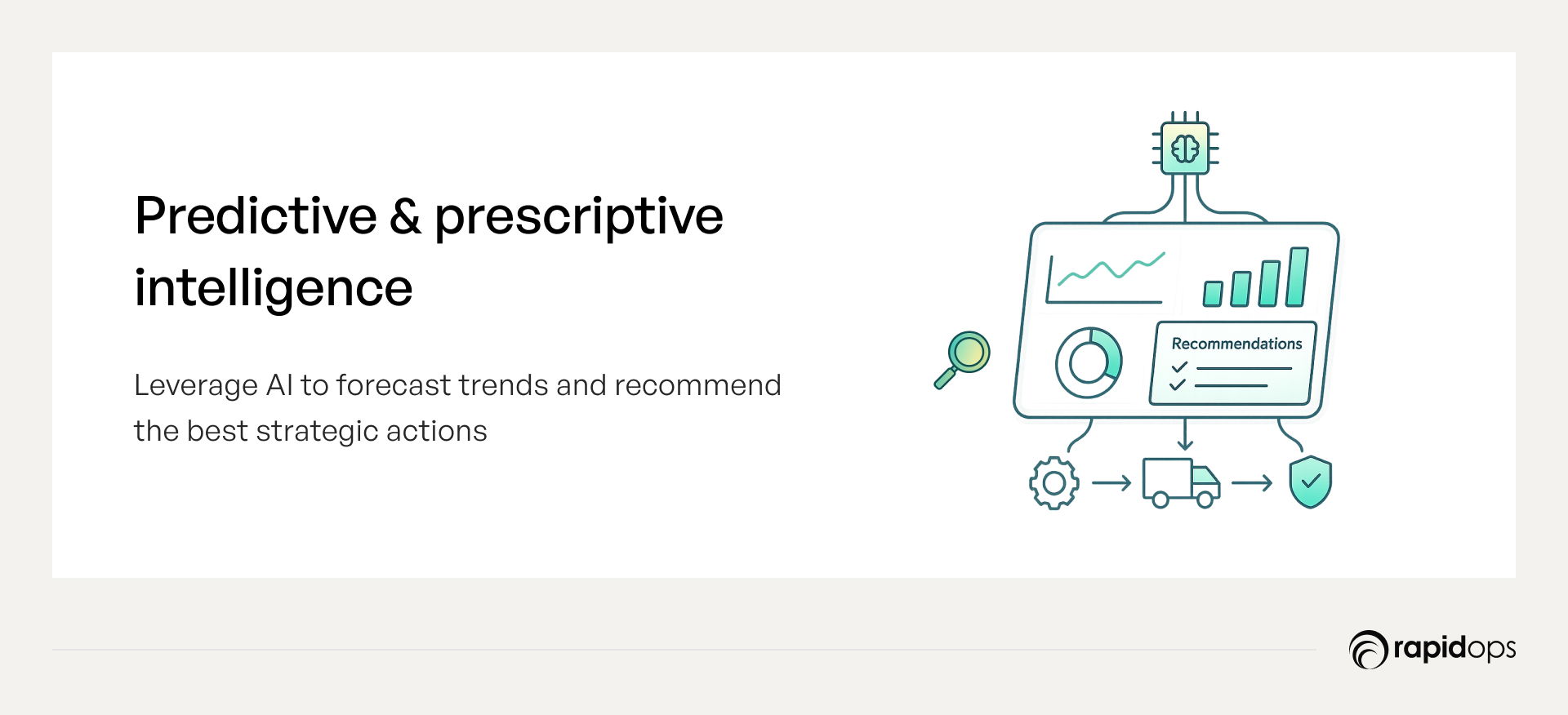
Enabling autonomous enterprise insights
Predictive and prescriptive intelligence via agentic AI involves autonomously processing structured and unstructured enterprise data, detecting patterns, generating insights, and recommending optimized actions. These agents adapt dynamically to changing conditions, coordinate across multiple datasets and operational areas, and act with minimal human intervention, enabling real-time, data-driven enterprise decisions.
Real-world applications
- Demand forecasting: Agentic AI agents autonomously analyze historical sales, market signals, and customer behavior, predicting demand fluctuations and dynamically adjusting supply chain and production strategies across the enterprise.
- Production scheduling: Coordinating across machines, resources, and order volumes, agentic AI agents autonomously optimize manufacturing schedules, ensuring efficiency, minimizing bottlenecks, and responding instantly to operational changes.
- Inventory management: Agentic AI continuously monitors inventory levels, sales velocity, and supplier performance, autonomously recommending replenishments, redistribution, and stock balancing to reduce overstock, prevent shortages, and improve cash flow.
Measurable business impact
Organizations leveraging agentic AI report higher accuracy in operational decisions, greater efficiency, reduced costs, and faster responsiveness. By shifting from reactive reporting to proactive, autonomous intelligence, enterprises achieve both operational excellence and strategic agility.
Strategic relevance
Agentic AI-driven intelligence enables enterprise-wide proactive planning, risk mitigation, and operational resilience. Insights generated inform hyper-personalized engagement strategies, cross-functional coordination, and forward-looking initiatives, making predictive and prescriptive intelligence a cornerstone of AI-driven enterprise operations.
7. Hyper-personalized customer engagement
In 2025, customer expectations demand dynamic, relevant, and anticipatory experiences. Agentic AI enables enterprises to meet these expectations by deploying AI agents that autonomously analyze individual customer behaviors, preferences, and interactions to deliver tailored offers, content, and pricing at scale.
Early adopters are already seeing measurable gains in engagement, conversion, and loyalty, demonstrating how agentic AI is transforming the way businesses interact with their customers.
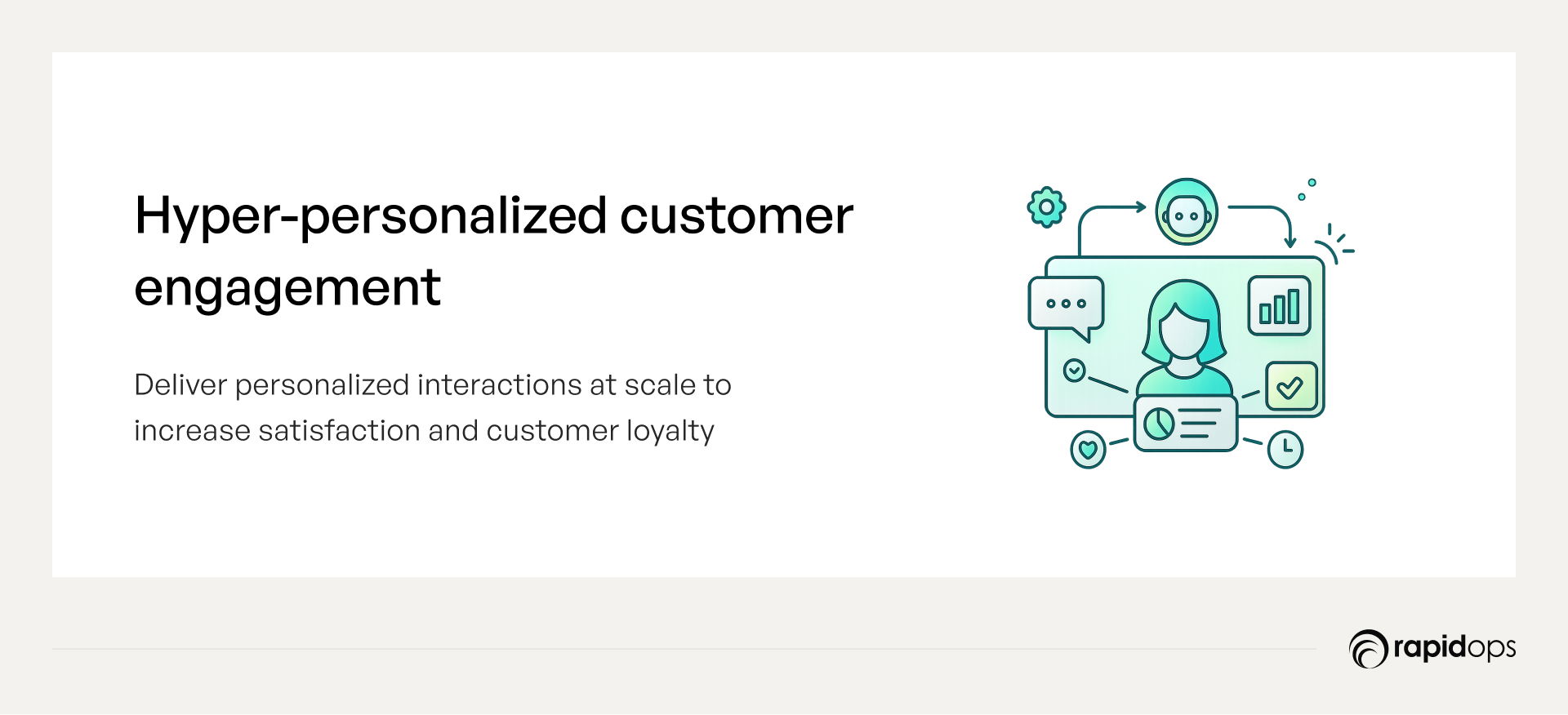
Autonomous customer experience at scale
Agentic AI agents continuously analyze customer behaviors, preferences, and interactions in real time, autonomously adapting engagement across marketing, sales, and service channels. This capability enables enterprises to deliver hyper-personalized experiences consistently at scale, without requiring constant human intervention. By detecting patterns, anticipating needs, and optimizing interactions, these agents ensure that every touchpoint is relevant, timely, and tailored to individual customers.
Real-world applications
- Personalized recommendations: Agentic AI agents autonomously curate product, service, or content suggestions based on real-time customer behavior, preferences, and past interactions, ensuring relevance and engagement.
- Targeted campaigns: Marketing efforts are optimized as agentic AI dynamically segments audiences, determines the most effective channels, and delivers adaptive messaging with minimal manual intervention.
- Adaptive pricing: AI agents analyze market conditions, customer segments, and purchase history to autonomously adjust pricing strategies, maximizing conversion and revenue.
Measurable business impact
Organizations leveraging agentic AI for customer engagement report higher engagement, increased conversion rates, enhanced customer loyalty, and optimized revenue generation. Autonomous personalization reduces operational overhead while maintaining consistent, relevant interactions at scale.
Strategic relevance
Agentic AI-driven personalization strengthens customer relationships, supports revenue growth, and informs enterprise knowledge automation and decision intelligence. By enabling autonomous, adaptive, and real-time engagement, enterprises achieve a sustainable competitive advantage while enhancing operational efficiency and strategic insight.
8. Knowledge automation and decision intelligence
In complex enterprises, actionable insights often remain trapped across silos, delaying critical decisions. Agentic AI addresses this by deploying AI agents that autonomously aggregate, analyze, and synthesize enterprise data, transforming fragmented information into strategic, real-time intelligence.
Organizations adopting these systems are already seeing measurable gains in speed, accuracy, and operational coordination, reinforcing the transformative potential of agentic AI trends 2025.
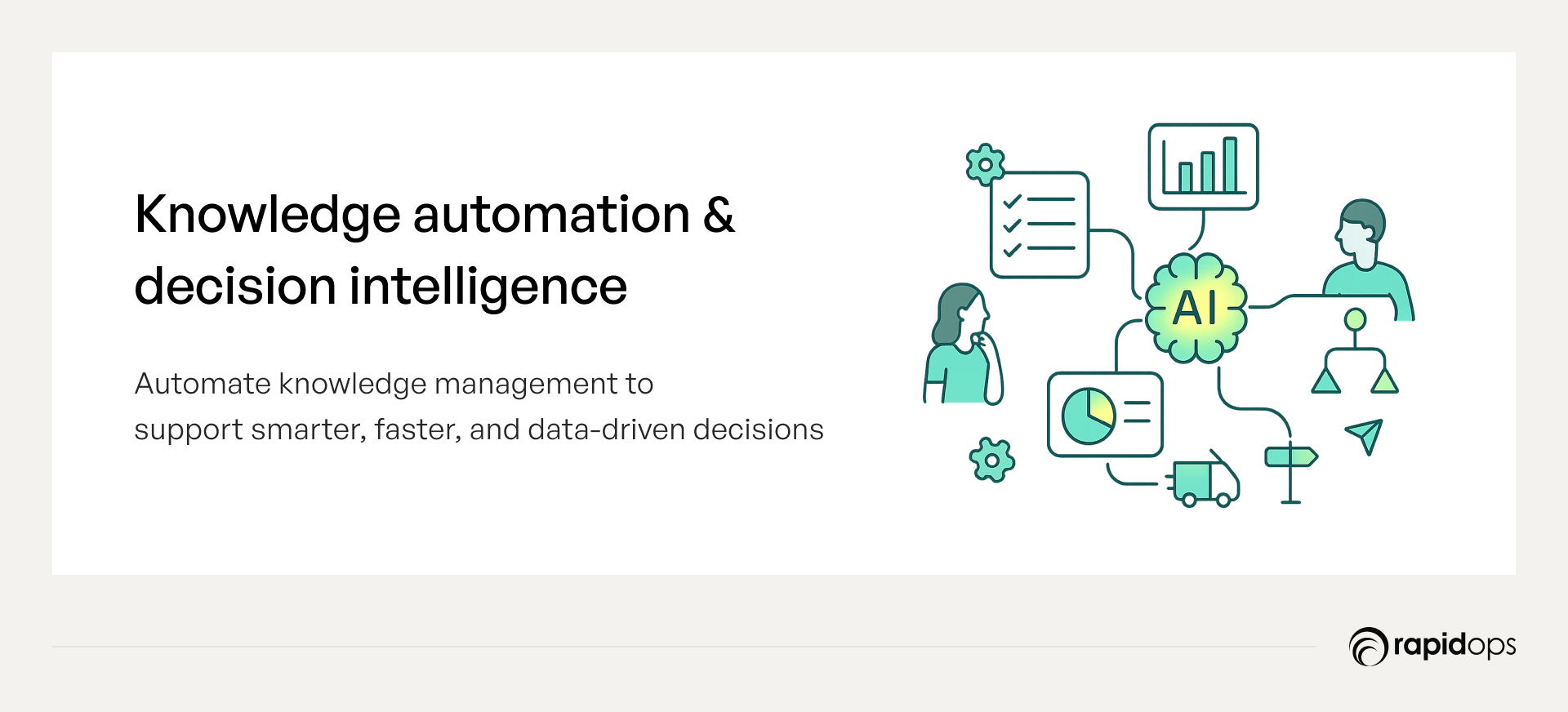
Transforming knowledge automation through agentic AI
Agentic AI autonomously integrates and analyzes data across enterprise systems, uncovering patterns, risks, and opportunities in real time. Continuously learning from historical and live inputs, these AI agents generate actionable insights, optimize workflows, and support proactive decision-making. By converting fragmented information into dynamic intelligence, agentic AI ensures enterprises act faster, respond confidently to market shifts, and turn knowledge into a strategic, operational advantage.
Real-world applications
- Automated reporting: Agentic AI autonomously consolidates departmental and enterprise-wide data, generating real-time insights without manual intervention.
- Proactive risk detection: AI agents identify anomalies, compliance risks, or operational vulnerabilities across systems, providing early warnings and prescriptive actions.
- Cross-departmental intelligence: Agentic AI connects knowledge from finance, operations, marketing, and supply chain systems, delivering integrated insights that inform enterprise-wide strategy and planning.
Measurable business impact
Enterprises leveraging agentic AI for knowledge automation achieve faster decision cycles, higher accuracy in critical business decisions, and reduced reliance on static reporting, translating insights directly into measurable outcomes.
Strategic relevance
By converting dispersed enterprise data into coherent, actionable intelligence, agentic AI enables organizations to gain a strategic advantage, foster cross-functional alignment, and support adaptive, informed decision-making at scale. As agents coordinate knowledge across silos, emergent intelligence drives continuous learning and collective enterprise adaptation, further reinforcing agility and resilience.
How agentic AI accelerates enterprise operations in 2025
In 2025, agentic AI is the catalyst for a significant shift in enterprise operations. By blending autonomous intelligence with human AI collaboration, AI agents are enabling businesses to scale, respond, and innovate faster than ever before. These agentic AI systems not only perform routine tasks but also solve complex problems, driving measurable business value and competitive advantage.
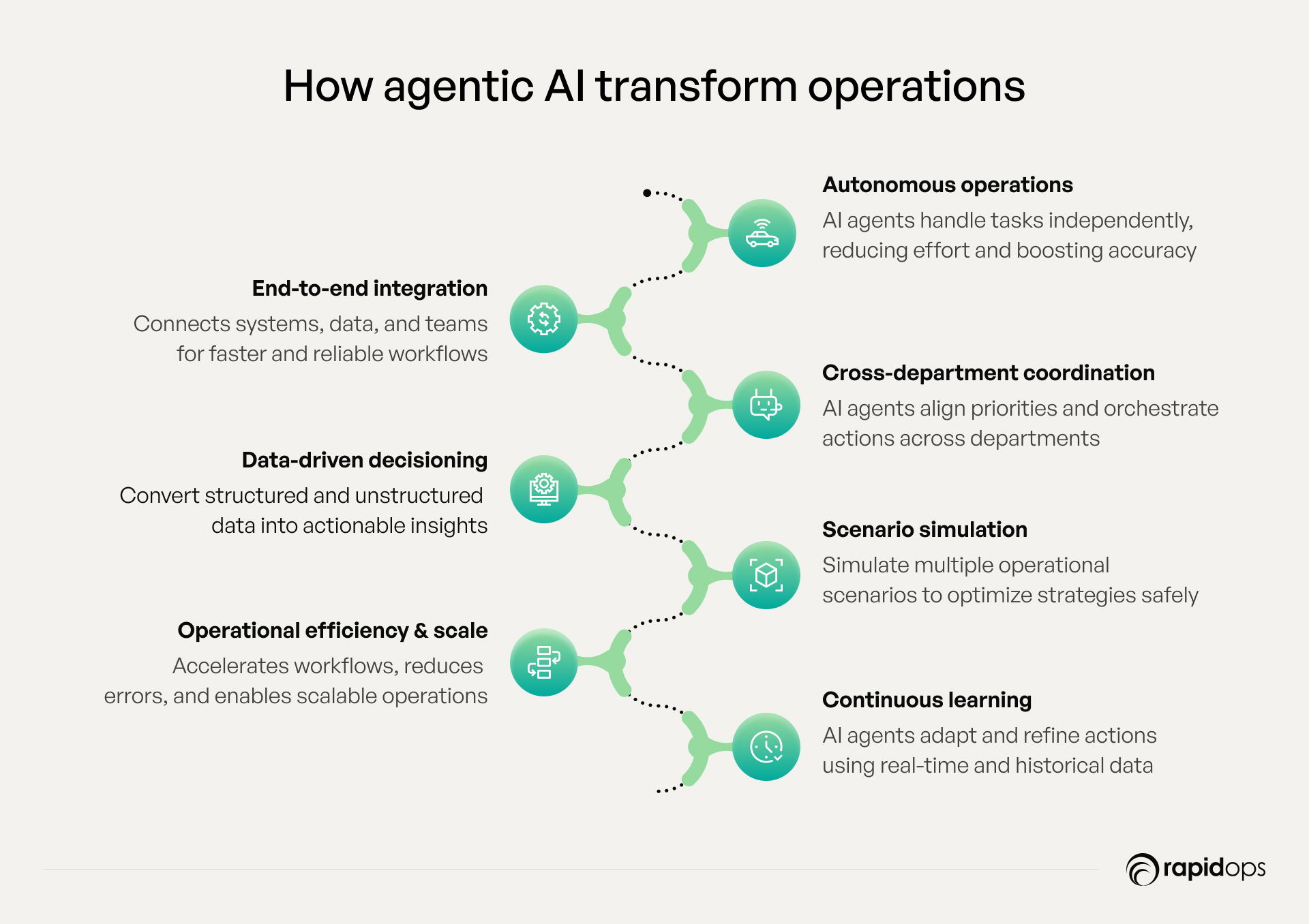
1. Autonomous operations
AI agents autonomously manage both routine and complex tasks, reducing human effort while maintaining precision, reliability, and ensure compliance. From procurement approvals to inventory adjustments, acting autonomously, these agents allow teams to focus on strategy and innovation. By leveraging advanced AI capabilities, enterprises can autonomously plan and execute operations with minimal human intervention, reducing operational overhead and accelerating outcomes.
2. End-to-end workflow integration
Agentic AI embeds itself across processes, connecting systems, data, and teams for faster, more accurate, and dependable outcomes. Integrated workflows ensure that every step, from data collection to decision execution, is streamlined and aligned with organizational objectives.
3. Cross-departmental coordination
Through multiple AI agents and multi-agent systems, enterprises achieve coordinated operations across departments. By sharing insights and orchestrating actions in real time, AI systems eliminate silos, align priorities, and optimize real world applications. This human AI collaboration ensures that strategic business goals are met efficiently while fostering adaptive learning across teams.
4. Data-driven decision intelligence
By converting structured and unstructured data into actionable insights, AI agents enable predictive and prescriptive analytics at scale. Enterprises gain foresight into market trends, risk management, and changing environments, allowing leaders to anticipate challenges and respond proactively. This knowledge base of real-time analytics strengthens decision-making processes and enhances enterprise resilience.
5. Strategic scenario simulation
Agentic AI models simulate multiple operational scenarios, helping leaders explore risks, optimize strategies, and validate decision making before critical execution. By combining large language models, generative AI, and model context protocol, enterprises can test strategies in real world applications with minimal human input, mitigating risk and improving confidence in complex problem-solving.
6. Operational efficiency and scale
AI solutions optimize core workflows, accelerate cycle times, and reduce errors while maintaining continuous learning. By autonomously managing time-sensitive tasks, agentic AI systems allow enterprises to scale operations without proportional increases in human input, delivering measurable productivity gains and fostering competitive advantage across departments and regions.
7. Continuous learning and improvement
Through adaptive learning, AI agents analyze historical and real-time data to refine actions continuously. This ensures strategies evolve with emerging opportunities, regulatory changes, and real world dynamics. Continuous learning also improves predictive analytics, enabling enterprises to perform tasks smarter, reduce operational overhead, and maximize business value over time.
By synthesizing enterprise data across silos, specialized agents uncover interdependencies, bottlenecks, and growth opportunities. The holistic view provided by agentic AI systems drives data-driven decision intelligence, accelerates innovation, and equips leaders to act autonomously with confidence. Leveraging these insights ensures AI capabilities directly translate into operational efficiency, strategic foresight, and sustainable advantage.
Core technologies driving enterprise agentic AI
Agentic AI’s transformative impact relies on a robust set of AI capabilities that empower enterprises to act with intelligence, agility, and precision. In 2025, these technologies are actively shaping how organizations perform tasks, manage complex problems, and achieve business goals. Understanding these core technologies is essential for leaders aiming to maximize business value through agentic AI systems.
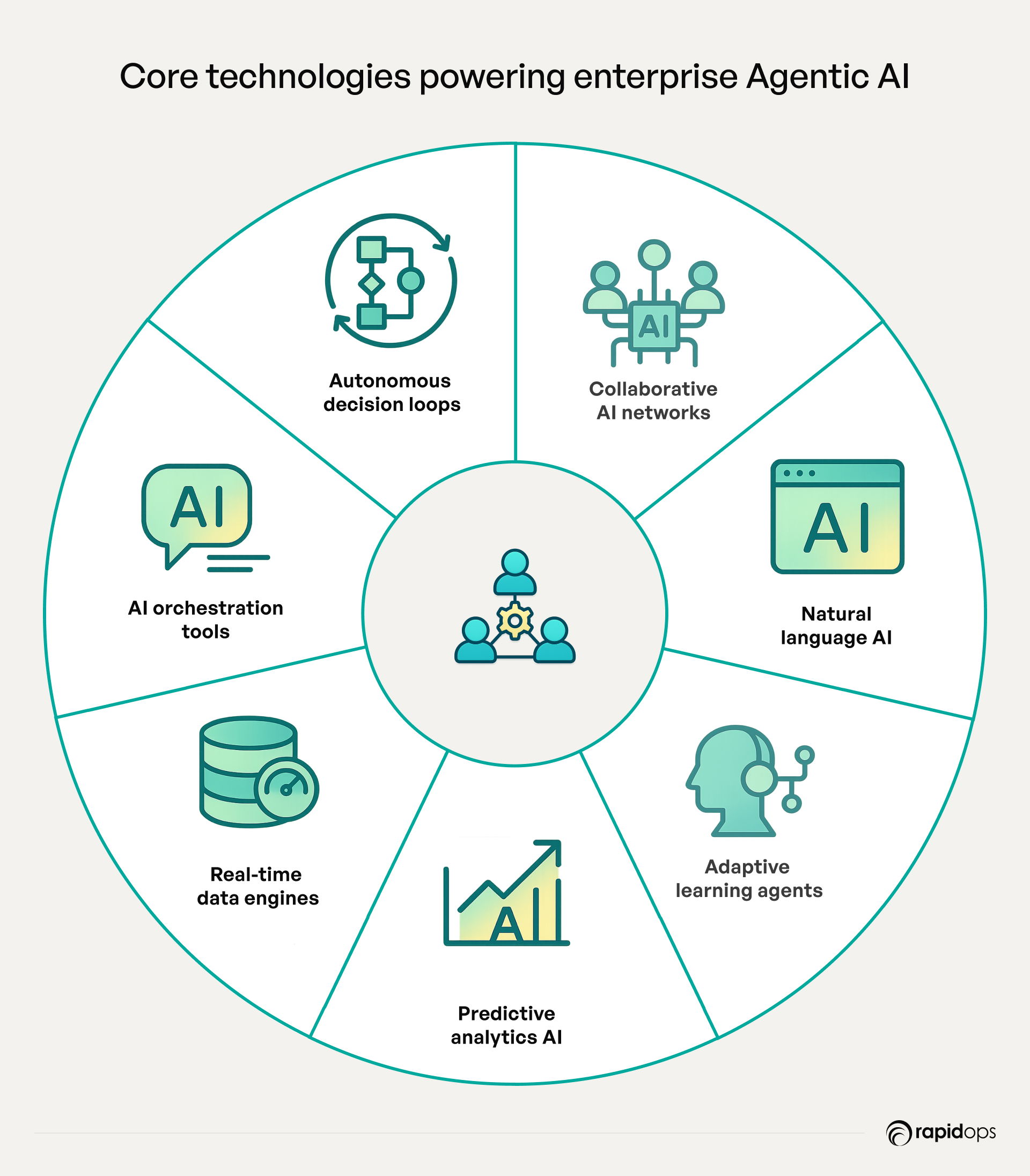
1. Advanced reasoning and autonomous decision loops
Modern AI agents go beyond simple automation, leveraging advanced reasoning and autonomous decision making to navigate complex tasks. By evaluating scenarios, weighing trade-offs, and acting autonomously, these agents accelerate processes while ensuring alignment with core workflows and strategic objectives. This capability drives measurable productivity gains and reduces operational overhead, creating clear enterprise impact.
2. Multi-agent systems and collaborative intelligence platforms
Multiple AI agents operating within agentic systems form collaborative networks that communicate, share insights, and coordinate across departments. Such human AI collaboration ensures that decisions reflect broader organizational context, optimizes enterprise data usage, and reduces silos. Dynamic environments benefit from these ecosystems, as continuous learning enables agents to adapt strategies in real-time while supporting decision making processes across the enterprise.
3. Natural language processing (NLP)
Through natural language processing and contextual understanding, AI models interpret unstructured data from documents, customer interactions, and communications. This capability allows agentic AI systems to generate actionable insights, enhance real world applications, and support data-driven decision making at scale. Agents can bridge human insight with automated execution, ensuring minimal human intervention without compromising quality.
4. Reinforcement learning and adaptive algorithms
Specialized agents continuously refine their strategies using adaptive learning and reinforcement techniques. By responding to changing environments and operational shifts, these agents enhance predictive performance, reduce the need for human input, and solve complex problems autonomously. Over time, they optimize processes, delivering competitive advantage and boosting productivity across enterprise operations.
5. Predictive and Prescriptive Analytics Models
Advanced predictive analytics and prescriptive models allow agentic AI to anticipate trends, recommend optimal actions, and proactively mitigate risks. By harnessing both enterprise data and insights from multiple AI agents, organizations can make faster, foresight-driven decisions that minimize uncertainty while supporting strategic business goals.
6. Real-time data processing and integration engines
Agentic AI systems rely on continuous streams of structured and unstructured data. Real-time processing ensures AI agents act on the most current information, while integration with enterprise systems connects disparate platforms. This enables seamless core workflows, synchronized intelligence, and actionable insights at the speed of business.
7. AI orchestration frameworks (APIs, Low-code/No-code platforms)
Robust frameworks, including API-driven and low-code/no-code platforms, allow enterprises to deploy, monitor, and scale agentic AI systems efficiently. These frameworks enable human-AI collaboration, maintain compliance, and reduce operational overhead, ensuring that AI solutions integrate seamlessly with existing infrastructure while remaining flexible to evolving business needs.
Collectively, these technologies empower agentic AI to operate autonomously yet intelligently, transforming real-world applications, improving decision-making, and unlocking measurable business value. Early adopters report faster operations, smarter AI-driven decision-making, and enhanced strategic agility, demonstrating how agentic AI systems are defining the future of enterprise growth.
Emerging challenges in agentic AI adoption
The rise of agentic AI systems is creating a significant shift in enterprise operations. While AI agents enable autonomous task performance, organizations face emerging challenges in adopting them. Recognizing these hurdles is critical to unlocking business value, managing operational overhead, and ensuring compliance in complex, dynamic environments.
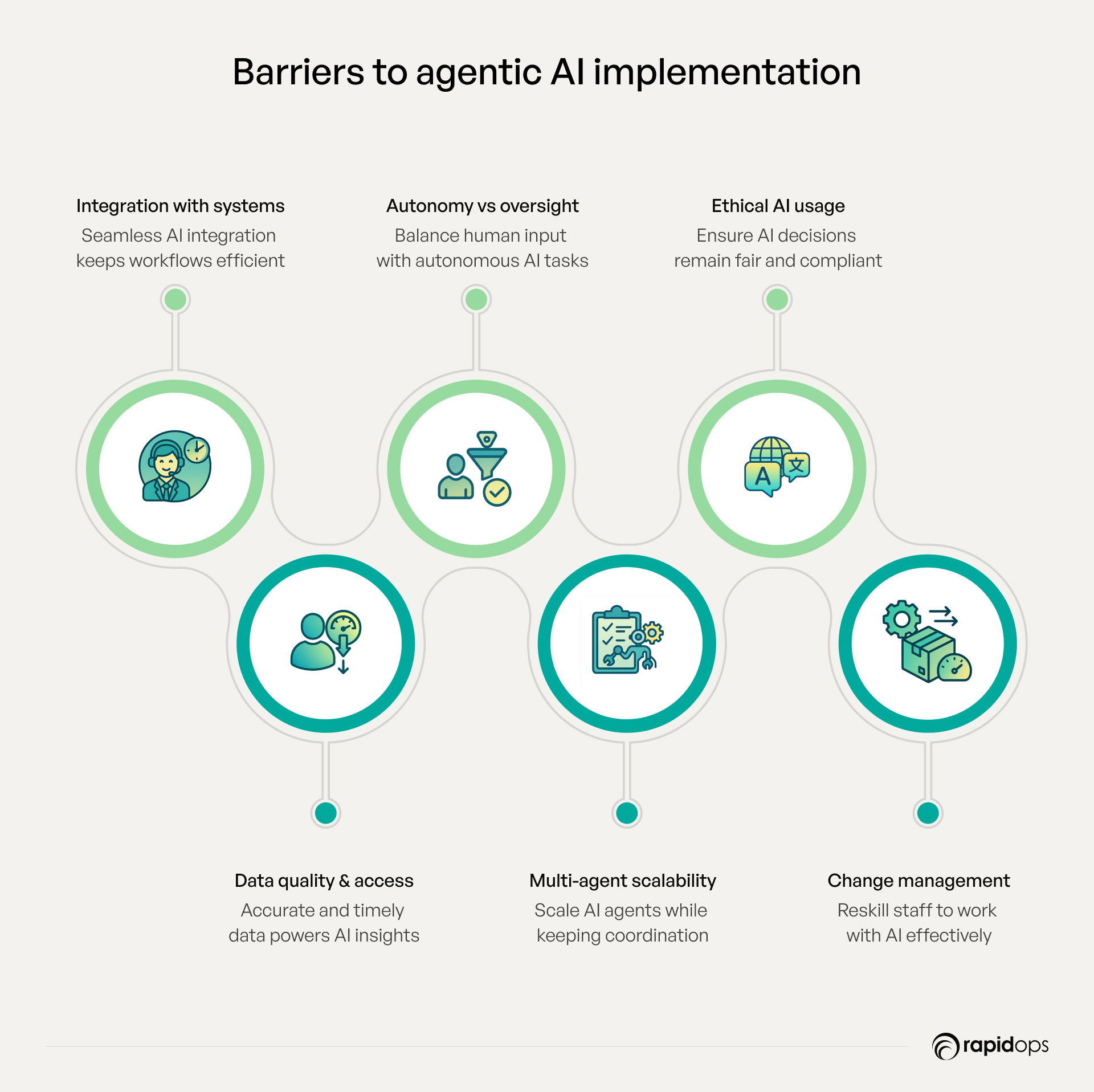
Integration with existing enterprise systems
Seamless integration of agentic AI with legacy ERP platforms, cross-departmental workflows, and other AI systems is essential. Enterprises must enable multiple AI agents to communicate effectively with existing infrastructure to avoid operational disruption. Proper agent orchestration ensures that AI models function cohesively within core workflows, maintaining efficiency while enabling autonomous decision-making.
Data quality and accessibility
The effectiveness of AI agents relies on accurate, timely, and comprehensive enterprise data. Incomplete, siloed, or inconsistent datasets can compromise the ability of specialized agents to solve complex problems or act autonomously. Implementing robust governance frameworks, data cleansing strategies, and ensuring human AI collaboration enhances the predictive analytics capabilities of AI systems, powering actionable insights for executives.
Autonomy vs. human oversight
Balancing minimal human intervention with selective oversight is key. While agentic AI systems excel at performing repetitive or rule-based tasks autonomously, human input is critical for complex tasks, high-stakes decisions, and ensuring ethical adherence. This human-on-the-loop approach strengthens trust, accountability, and decision making processes, without compromising productivity gains.
Scalability of multi-agent ecosystems
Expanding multiple AI agents across departments, geographies, and business units introduces coordination and resource challenges. Effective human AI collaboration and continuous learning mechanisms allow agents to share insights, adapt in dynamic environments, and optimize real world applications. This ensures scalable AI adoption that supports enterprise growth and maintains a competitive advantage.
Ethical and responsible AI usage
Responsible deployment of agentic AI systems demands adherence to ethical guidelines, regulatory compliance, and bias mitigation. Governance frameworks should oversee autonomous decision making, protect stakeholders, and ensure AI-driven processes align with business goals. Maintaining ethical standards strengthens trust and safeguards long-term business value in AI initiatives.
Change management and workforce adaptation
Adoption of agentic AI is as much about people as technology. Enterprises must reskill employees, embed AI fluency into corporate culture, and encourage human AI collaboration to maximize productivity gains. Strategic workforce adaptation ensures that specialized agents complement human expertise, enabling continuous learning and effective execution of core workflows.
Addressing these challenges enables organizations to realize the full promise of agentic AI. With specialized agents, robust enterprise data, and effective human AI collaboration, businesses can achieve autonomous decision making, improved predictive analytics, and enhanced real world applications. Ultimately, thoughtful adoption delivers measurable business value, competitive advantage, and scalable AI-driven transformation.
Turning agentic AI into a strategic growth engine
The era of Agentic AI is here, transforming the way businesses operate at every level. From automating end-to-end workflows to enabling intelligent operations and hyper-personalized customer experiences, organizations that have adopted it are already seeing faster outcomes, sharper insights, and stronger resilience.
For businesses yet to embrace these capabilities, understanding their potential is critical, not just to stay competitive but to unlock new levels of operational agility and strategic advantage.
At Rapidops, we work closely with enterprises to design, deploy, and continuously optimize agentic AI and AI agents tailored to their unique business needs. By turning agentic AI into a growth engine, we help organizations reduce manual effort, accelerate processes, and scale innovation across the enterprise, ensuring that AI doesn’t just support your business, it becomes a core driver of transformation and measurable impact.
Curious about the value agentic AI can unlock for your business? Schedule a strategy call with our AI experts to identify which processes can deliver the highest impact, where AI agents can drive maximum growth, and what ROI you can realistically expect.
Frequently Asked Questions
Which enterprise departments benefit most from agentic AI?
Agentic AI delivers value across departments handling high-volume, data-driven, or repetitive tasks. Operations benefit from automated workflow orchestration, reducing errors and cycle times. Supply chain teams gain predictive insights to anticipate disruptions and optimize logistics. Finance and compliance departments can streamline reporting and enhance risk management. Marketing and customer experience teams leverage hyper-personalized engagement agents to improve retention and satisfaction. Essentially, any department relying on structured data, decision intelligence, and interdepartmental coordination can achieve measurable impact.
What training is required for employees to work alongside agentic AI?
Employees need targeted training that combines AI literacy with process understanding. Non-technical staff should learn to interpret AI insights, monitor workflows, and handle exceptions. Technical teams focus on managing, customizing, and optimizing agent behavior. Change management is essential: fostering a culture that views AI as a collaborative partner ensures adoption, minimizes resistance, and maximizes productivity gains.
Are there industries where agentic AI adoption is more challenging?
Yes, industries with strict regulatory requirements such as healthcare, finance, and defense, face additional hurdles around compliance, security, and privacy. Enterprises with fragmented or siloed data, or heavily legacy-dependent IT systems, may also see slower adoption. By tailoring AI deployment strategies, ensuring robust governance, and starting with pilot programs, enterprises can overcome these challenges while minimizing risk.
What are the limitations of current agentic AI technologies?
Agentic AI depends heavily on high-quality, structured data; poor or biased datasets can compromise outcomes. Integration with legacy systems can be complex and resource-intensive. Agents may struggle with ambiguous or highly contextual scenarios requiring nuanced human judgment. Additionally, autonomous systems demand ongoing oversight, ethical governance, and performance monitoring to maintain reliability and compliance.
What is the impact of agentic AI on enterprise innovation?
Agentic AI accelerates innovation by automating repetitive processes, enabling teams to focus on strategy, creativity, and product development. Multi-agent ecosystems allow cross-functional collaboration and faster decision cycles, uncovering insights hidden in complex datasets. Over time, organizations adopting agentic AI develop a culture of data-driven experimentation and continuous improvement, enhancing competitive advantage.
What are the signs that an enterprise is ready for agentic AI adoption?
Enterprises are ready when they face repetitive, data-intensive workflows, fragmented decision-making, and operational bottlenecks. Additional signs include strong leadership alignment on digital transformation, a culture of agility, clean and structured data availability, and readiness to invest in AI infrastructure and governance frameworks.
How should enterprises plan for agentic AI scalability?
Scalability requires a structured approach: begin with modular deployment targeting high-impact use cases, define clear KPIs for agents, and implement monitoring dashboards to track performance. Leverage cloud-based platforms and APIs for seamless expansion across departments and geographies. Continuous performance evaluation, iterative optimization, and employee readiness ensure consistent efficiency, compliance, and long-term ROI as agentic AI adoption grows enterprise-wide.

Rahul Chaudhary
Content Writer
With 5 years of experience in AI, software, and digital transformation, I’m passionate about making complex concepts easy to understand and apply. I create content that speaks to business leaders, offering practical, data-driven solutions that help you tackle real challenges and make informed decisions that drive growth.
What’s Inside
- Why agentic AI matters for enterprises in 2025
- Top agentic AI trends in 2025
- 1. Autonomous enterprise workflows
- 2. Multi-agent collaboration ecosystems
- 3. Human-on-the-loop for complex workflows
- 4. Industry-specific agents replacing generic copilots
- 5. AI agents for supply chain resilience
- 6. Predictive and prescriptive enterprise intelligence
- 7. Hyper-personalized customer engagement
- 8. Knowledge automation and decision intelligence
- How agentic AI accelerates enterprise operations in 2025
- Core technologies driving enterprise agentic AI
- Emerging challenges in agentic AI adoption
- Turning agentic AI into a strategic growth engine

Let’s build the next big thing!
Share your ideas and vision with us to explore your digital opportunities
Similar Stories
- AI
- 4 Mins
- September 2022

- AI
- 9 Mins
- January 2023


Receive articles like this in your mailbox
Sign up to get weekly insights & inspiration in your inbox.

